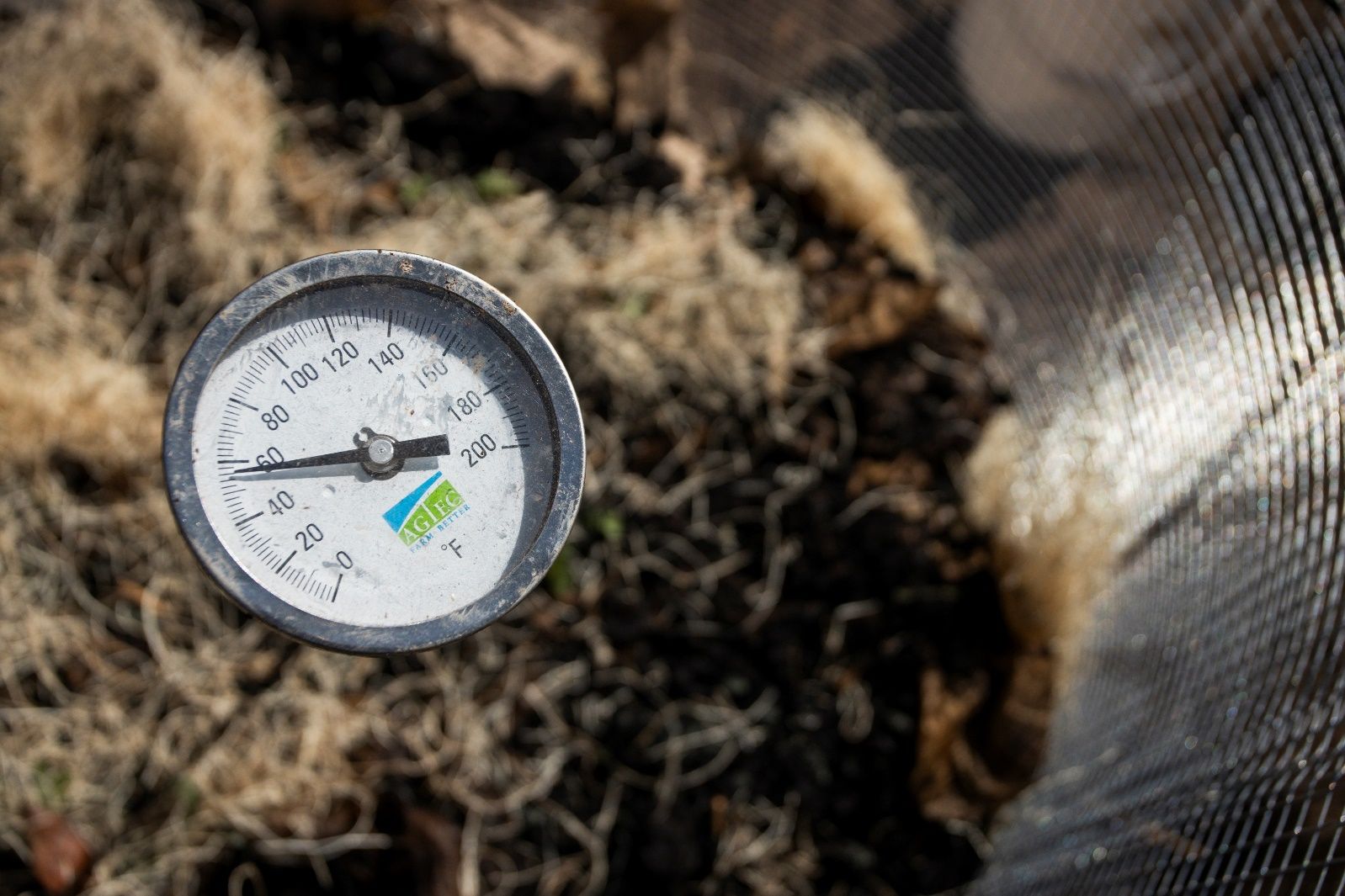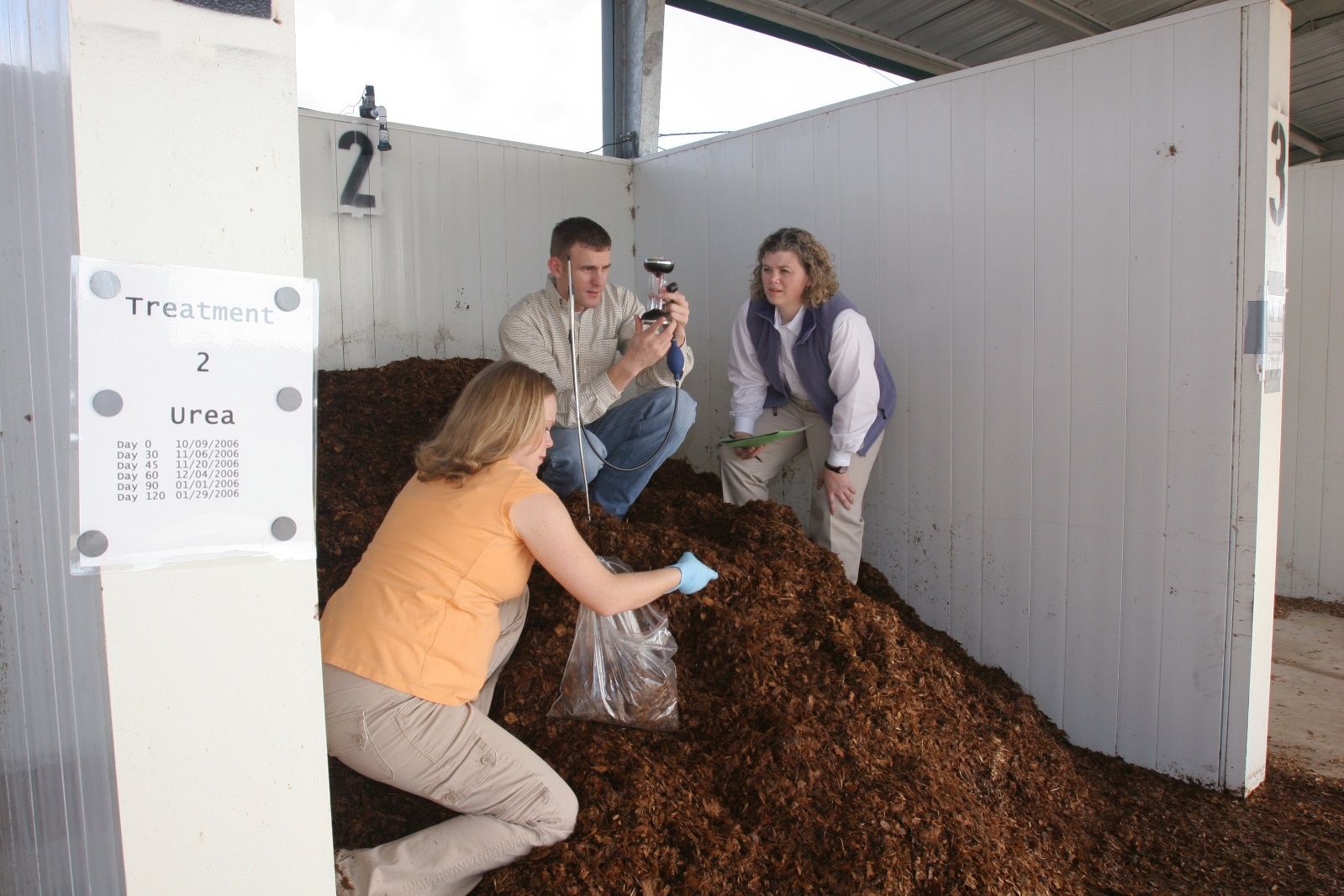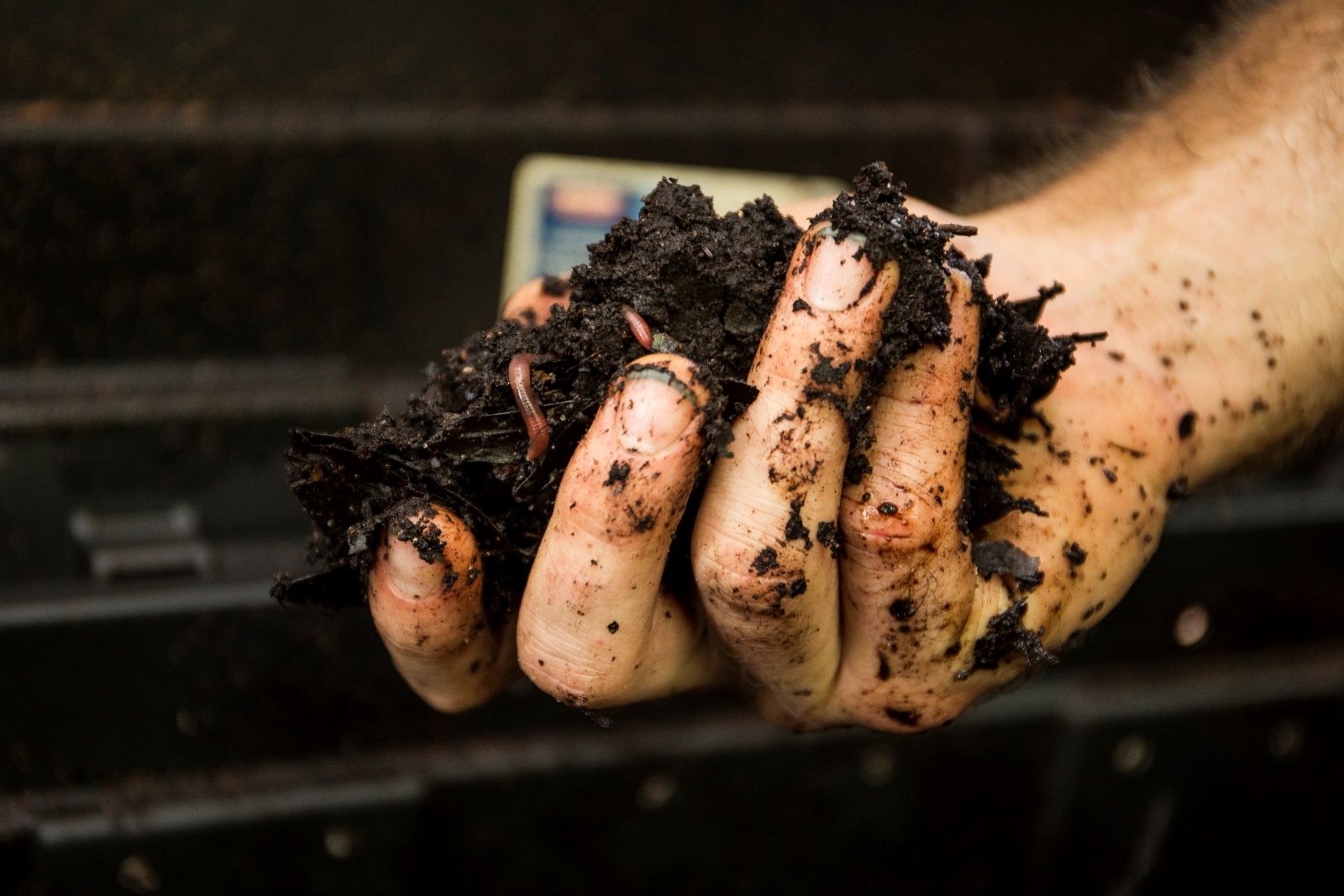Introduction
This document is the second in a two-part series on composting horse manure on small farms. The first article discussed some benefits of composting horse manure, as well as how to select a location for a compost bin system on your small farm. The purpose of this article is to share some how-to tips on building and managing manure compost bins. Both articles in this series complement an older publication on horse-manure composting by providing more up-to-date science, illustrations, and hands-on how-to advice for horse owners. Both articles also rely on information provided by the Florida Department of Environmental Protection (DEP) but condense the longer DEP booklet into a web- and mobile-friendly format with illustrative examples and instructions for maintaining and using compost. This article is intended for noncommercial horse owners.
Horse manure can be composed of raw manure removed from paddock or pasture spaces, or if horses are housed in stalls, manure will often include spent pine shavings or another type of bedding material. Composting is a natural process driven by microorganisms that occur naturally in raw horse manure and stall waste. Understanding the factors that promote the composting process and how to balance them properly will help you effectively manage your compost bins.
Successful Composting
The process of manure composting is thought of as both an art and a science, and learning by doing is the best way to fine-tune a particular compost system. The following criteria work in tandem to effectively compost the material in a compost pile. When troubleshooting the needs of a compost system, look to each of these elements as parts of a whole process.
- Nutrients—Microbes in the compost pile rely on carbon, nitrogen, and other elements present in the materials that make up the pile for their metabolic processes and their growth. Carbon and nitrogen are the two most vital elements that microbes need, and the efficiency with which the microbes decompose the pile depends on the ratio of these two elements. For manure composting, the most ideal carbon-to-nitrogen ratio (C:N) is 30:1. This means that for every 30 units of carbon, there should be 1 unit of nitrogen. This can be a tricky element to keep in check, because while raw manure fresh from the horse is close to that 30:1 ratio, the carbon component increases as soon as stall bedding material is added to the pile, resulting in a ratio greater than the ideal 30:1. A method to adjust this ratio would be to amend the pile with an additional nitrogen source. For examples of how to adjust your carbon and nitrogen levels, see “What Can I Compost?”
- Oxygen Availability—As livings beings, the microbes also rely upon oxygen to survive and perform their work. The microbes release energy through aerobic respiration, meaning that they need oxygen to properly metabolize compounds. In other words, making sure the compost pile has sufficient aeration will help speed up the decomposition process by allowing the microbes to work more efficiently. This can be achieved partially through the design of the compost bins, such as leaving spacing between the materials that comprise the walls of the bins to allow airflow, and primarily through management of the compost by turning the piles to incorporate oxygen. To reduce labor and time inputs, composting systems can also be designed in consultation with a company that specializes in compost systems with built-in aeration using forced air.
- Moisture—Water is another key ingredient that microorganisms require to support their metabolic processes and growth. If the materials in your compost bins become too dry, decomposition will be hindered, and this will prevent your compost from developing in a timely manner. On the other hand, too much moisture can saturate the microbes, which will prevent proper oxygen flow and increase the compaction of the compost particles. Microbial activity is highest and most efficient at a moisture level of about 40–50 percent. A long-stem moisture meter can be inserted into the compost pile to measure and record moisture levels. A simpler, low-cost method for assessing whether compost piles are holding the appropriate moisture content is to check the texture of composting material by hand; material that has the feel of a wrung-out sponge is close to the ideal 40%–50% moisture.
- Temperature—The process of decomposition naturally results in an increase in temperature of the manure pile. This is due to the microorganisms producing heat as they carry out metabolic processes and release energy. Heat is another important ingredient in composting because higher temperatures yield faster decomposition. High heat is also beneficial for killing weed seeds and parasites. A temperature of about 130–160 degrees Fahrenheit (55–70 degrees Celsius) should be maintained throughout the manure pile for a period of 21 days for the most effective composting.

Credit: UF/IFAS Photo by Tyler Jones
How to Manage the Components of Composting
Now that you know the recipe for the successful composting of horse manure, it’s time to apply the appropriate measures of each component to your own compost bins. Listed below are some techniques to efficiently manage each component of composting horse manure:
- Nutrients—As mentioned above, the ideal carbon-to-nitrogen ratio for your manure mixture during composting is 30:1. Horse manure in its raw state contains the ideal amount of nitrogen, while stall bedding materials such as straw, pine needles, hay grass, and wood chippings are providing carbon. For context, the average C:N ratio of raw horse manure is about 20:1, whereas the average C:N ratios of the described bedding materials alone range from 40:1 to 400:1.
- What to Do: In order to bring your compost pile to a carbon-to-nitrogen ratio of approximately 30:1, add two parts bedding material for every one part raw manure.
- Keep in mind that the type of bedding material you are adding can alter the appropriate ratio of manure-to-bedding for your compost bins. Table 1 displays the wide range of C:N ratios for various bedding materials.
- Remember: Raw manure’s C:N ratio is already close to the ideal composting C:N ratio of 30:1, so adding less bedding material rather than more when troubleshooting is generally a safe bet.
- For further information about how to mix your compost ingredients based on your chosen bedding materials, review the sidebar entitled “Bedding Tips” on page 17 of the following publication: Warren, L. K., and C. Sweet. 2016. Caring for Alberta's Rural Landscape: Manure and Pasture Management for Horse Owners. Alberta Agriculture, Food, and Rural Development. https://open.alberta.ca/publications/2810416.
Table 1. C:N ratios for various bedding materials.
2. Oxygen Availability—By making sure you’ve added the appropriate amount of bedding materials to your compost bins, you’re already helping to increase the amount of airflow through your manure mixture. These larger materials allow for more empty space throughout the pile, which will facilitate aeration.
- What to Do: To keep consistent airflow throughout your compost bins during the whole composting process, it is recommended to thoroughly mix and turn the manure mixture at least once a week. This can be done with a large pitchfork for smaller compost bins or a tractor bucket for larger bins. If you are unable to mix your piles manually, another option is to insert multiple perforated PVC pipes into the mixture to help encourage oxygen circulation. However, mixing the piles manually once a week at the minimum will be more beneficial and will facilitate faster processing of the compost.

Credit: UF/IFAS File Photo by Sally Lanigan
3. Moisture—In order to have effective control over the moisture content of your compost bins, having the ability to cover the compost piles in the event of heavy rains will ensure the piles do become saturated. During dry weather conditions or if the compost piles contain larger amounts of carbon, water may need to be added.
- What to Do: Check the moisture level of your compost piles at least once a week. A simple guideline when it comes to moisture content of a compost pile is that it should be kept as damp as a wrung-out sponge. In other words, check to make sure your compost piles are wet, but not saturated. If your compost appears to be drying out on the outside, add water as you mix the pile to allow for an even moisture content throughout the pile.
- Tip: When adding water, use “old” water, such as water from the horse’s water troughs, before using fresh water.
- There are a few methods for measuring the moisture level of your compost piles. The easiest method is to test it by simply touching it to make sure it is still damp, but not excessively moist, as stated before. Another method is to use a soil moisture meter, which will tell you a more accurate percent value of water content. An ideal moisture content is around 40–50 percent.
4. Temperature—Temperature will increase naturally as a part of the compost process if the other elements of the composting process are maintained (adequate moisture, sufficient manure/bedding material amassed, and proper oxygenation).
- What to Do: To keep your compost piles at an internal temperature of 130–160 degrees Fahrenheit, practice proper mixing and watering techniques. Consistently mixing the compost piles in an effort to incorporate the material on the outermost layer of the compost pile to the hot, moist center of the pile will allow for a more uniform breakdown in material and will ensure all manure is being composted. Mixing the piles at least once per week as previously advised will also aid in temperature maintenance. To troubleshoot temperatures that are above the 130–160 degree range, maintain pile moisture and provide shade to the pile if possible.
- Note: These high temperatures that you are maintaining will result in a loss of moisture, which is a further reason to be consistently monitoring and adjusting your moisture levels as needed.
Composting Timescale and Record Keeping
If you practice these techniques consistently and adequately manage the various elements involved in manure breakdown through composting, you should have finished compost within 4 months. With the most intensive management, the composting process could be complete in as little as 6–8 weeks. However, this is on the extreme end of the composting timescale and is most likely achieved where daily intensive care and monitoring are part of the composting operation. Another method of composting known as “static pile” composting is on the other extreme end of the composting timescale. This is when manure and stall waste are simply piled up and left alone without any further management. Static pile composting can take anywhere from 6 months to 2 years to process, which is far less efficient and would not be suitable for small horse farms with more than one horse.
It is also worth keeping in mind that factors such as climate and pile size can alter the timescale for compost processing. In Florida, the light winters can allow for composting to persist year-round, whereas in other areas prone to harsh winters the composting process can lag during the cooler months. Consider your annual climate when determining how large of a compost bin system you will need based on the number of horses you have. It is recommended to keep records of measurements such as temperature, moisture level, and how often you mix the pile. These records can be used to document changes in the manure piles as they may relate to changing seasons or may signal a need to change a certain technique.
For some specific troubleshooting tips based on various symptoms that your compost pile may have, review Table 2 entitled “Troubleshooting Compost Operations” on page 15 of the following publication: Holland, K., M. K. Smith, M. Thomas, and C. Burger. 2013. Small Scale Horse Operations: Best Management Practices for Water Resource Protection in Florida. Tallahassee, Florida: Water Quality Evaluation & TMDL Program. https://floridadep.gov/water/industrial-wastewater/documents/bmps-small-scale-horse-operations.
Properties of Finished Compost

Credit: UF/IFAS Photo by Camila Guillen
Finished compost will look, smell, and feel like rich, dark potting soil and will no longer produce heat or have a high internal temperature. You should also notice a reduction in size of your compost piles by as much as half their volume simply due to material breakdown. Finished compost should no longer resemble raw horse manure and bedding materials. If you can still discern the original materials in the pile, then the process is not yet complete. One exception would be if you used wood chips as part of your bedding materials—these are significantly higher in carbon and contain the compound lignin, which takes a very long time to break down. Therefore, some wood chips may still appear in finished compost because they take the longest to decompose and are simply left over. This type of material can be used as mulch.
How to Utilize Your Finished Compost
A great advantage to managing horse manure by composting is the ability to manage your horse’s waste on-farm and potentially utilize the product as a farm benefit through a soil amendment. Finished compost serves as a great addition to our pastures and can increase soil organic matter (SOM) over time. Increasing soil organic matter is an underrated benefit of land application of compost; by increasing the SOM, the soil is better suited for holding moisture and nutrients, which has great implications for future fertilization events or rain events for a given area. Florida soils tend to be sandier in nature and therefore have a relatively low water- and nutrient-holding capacity. Horse manure does not tend to have high concentrations of nutrients such as nitrogen, but the limited supply it does have is transformed into a slow-release form of nitrogen through the composting process and is an ancillary advantage of land-applying compost.
Another avenue for finished compost would be for garden use, again as a soil enhancer providing the same benefits mentioned above for pasture. The use of compost in gardens is popular, and there may be ample opportunity for product placement in home gardens. What makes horse manure compost different from other sources of compost? Primarily the animal species the manure was generated from. Chicken manure is often used in commercial composting operations because it tends to have a higher nutrient concentration than horse manure and because pasture management is not a factor in the compost process. Pasture management on horse farms and the end use of compost come in to play when we consider the herbicides used to control pasture weeds on these farms. Some of the most widely used pasture herbicides contain the active ingredient aminopyralid, a great tool against pasture weeds affecting farms. This herbicide for pasture management will kill various crops such as tomatoes, lettuce, beans, and other common garden species. While gardeners will not intentionally apply aminopyralid herbicides to their gardens, they might be unaware of the residual that remains from these herbicides in compost from manure where the horses were consuming grass from treated pasture. The livestock consume grass that has been treated with an herbicide containing aminopyralid, they defecate, and the manure is composted, yet the aminopyralid residual persists even in the finished compost. This poses zero risk for being land-applied back onto the pasture or yard and is only a note of caution when intending to apply this compost to sensitive crops. For more information, see EDIS publication #SS-AGR-415, Herbicide Residues in Manure, Compost, or Hay: https://edis.ifas.ufl.edu/publication/AG416.
Sources
Holland, K., M. K. Smith, M. Thomas, and C. Burger. 2013. Small Scale Horse Operations: Best Management Practices for Water Resource Protection in Florida. Tallahassee, Florida: Water Quality Evaluation & TMDL Program. https://floridadep.gov/water/industrial-wastewater/documents/bmps-small-scale-horse-operations
Warren, L. K., and C. Sweet. 2016. Caring for Alberta's Rural Landscape: Manure and Pasture Management for Horse Owners. Alberta Agriculture, Food, and Rural Development. https://open.alberta.ca/publications/2810416. p. 9–13.
Wheeler, E. E. F. 2019. Horse Stable Manure Management. Penn State Extension. https://extension.psu.edu/horse-stable-manure-management. p. 7–10.